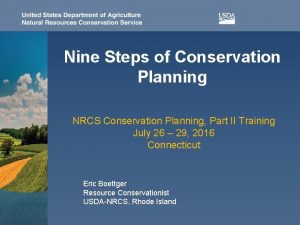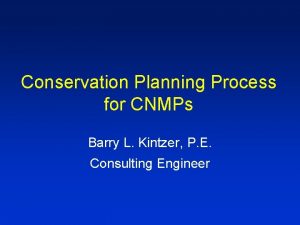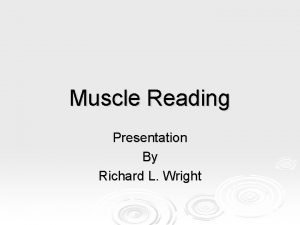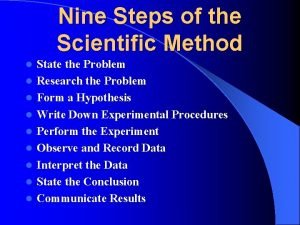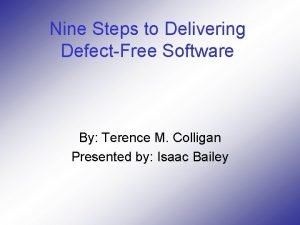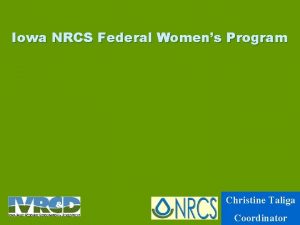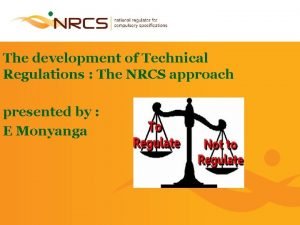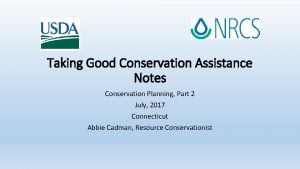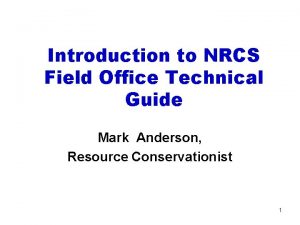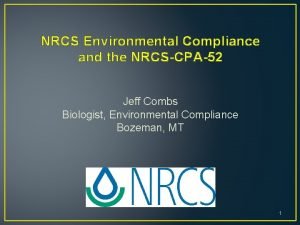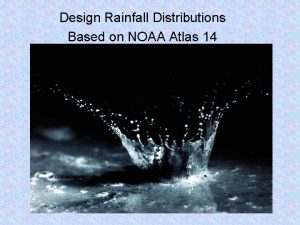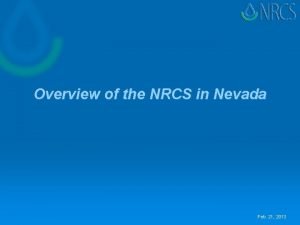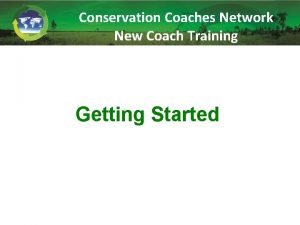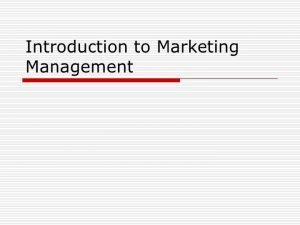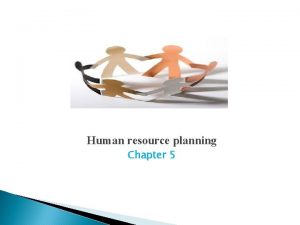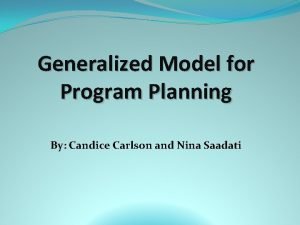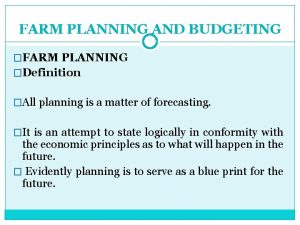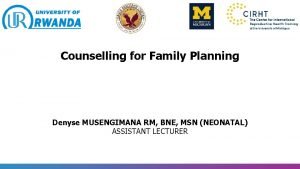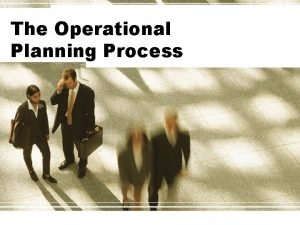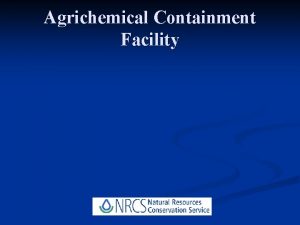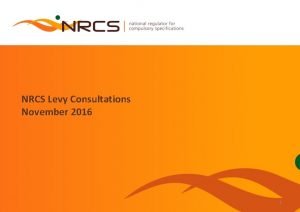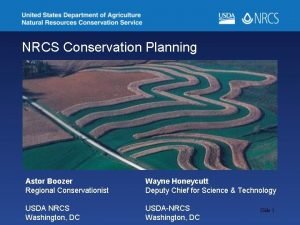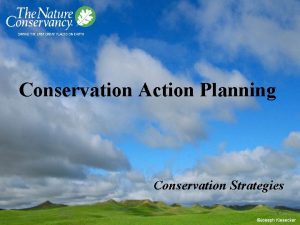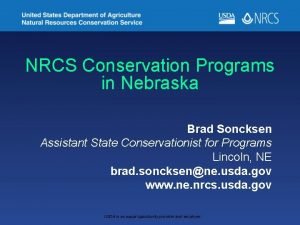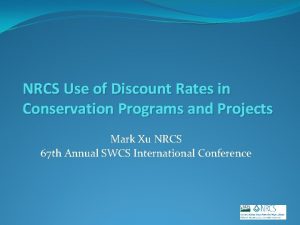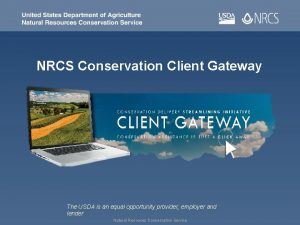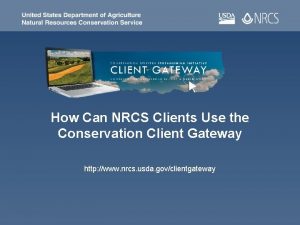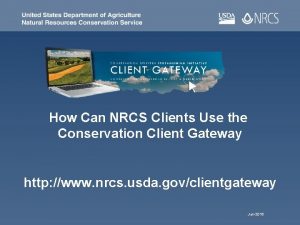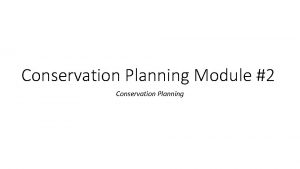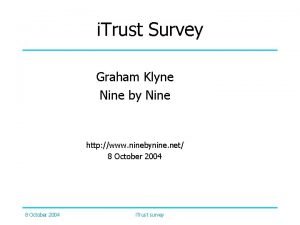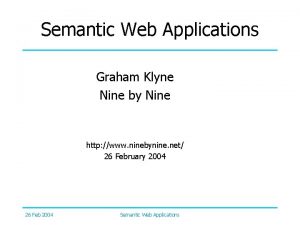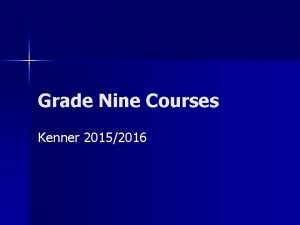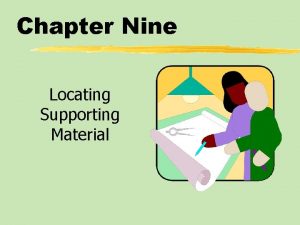Nine Steps of Conservation Planning NRCS Conservation Planning























- Slides: 23

Nine Steps of Conservation Planning NRCS Conservation Planning, Part II Training July 26 – 29, 2016 Connecticut Eric Boettger Resource Conservationist USDA-NRCS, Rhode Island

Nine Steps of Conservation Planning Step 1 - Identify Problems & Opportunities � Step 2 - Determine Objectives � Step 3 - Inventory Resources � Step 4 - Analyze Resource Data � Step 5 - Formulate Alternatives � Step 6 - Evaluate Alternatives using tools � Step 7 - Make decision � Step 8 - Implement plan � Step 9 - Follow-up �


Direction for applying the planning process Policy (1). —NRCS conservation planning policy is detailed in the 180 -GM, Part 409, “Conservation Planning Policy. ” 450 -GM, Part 401, “Technical Guides, ” describes NRCS policy for development of technical guides in support of the planning policy. NRCS policy for compliance with NEPA is located in the 190 -GM, Part 410, “Compliance With NEPA. ” Procedures (2) . —Title 180, National Planning Procedures Handbook, Part 600, supports the planning policy by describing the planning process and the how-to guidance used by NRCS to carry out that process. Title 190, National Environmental Compliance Handbook, Part 610, provides guidance on integrating the requirements of NEPA and other special environmental concerns into the planning process. Technical Guidance (3) . —The FOTGs are the primary technical reference for NRCS and are localized to apply specifically to an identified geographic area. The FOTG contains five sections supporting the technical aspects of conservation planning activities as identified below (see 450 -GM, Part 401, Sections 401. 3 to 401. 7, for content of FOTG): (i) I – General Resource References (ii) II – Natural Resources Information (iii) III – Resource Management Systems and Planning Criteria (iv) IV – Practice Standards and Specifications (v) V – Conservation Effects Tools (4) . —User guides for specific tools contain information for use and maintenance of conservation planning tools. (5) Program Guidance. —Manuals contain policy and guidance for administering programs that can facilitate implementation of planned measures.

Phase I – Collection and Analysis Understanding the Problems and Opportunities Step 1 – Identify problems and opportunities • Client interview • Site visit • Local knowledge and information

Phase I – Collection and Analysis Understanding the Problems and Opportunities Step 2 – Determine objectives • Develop an understanding with the client of the desired future conditions for the planning area. • Identify the client’s production and business goals for the operation.

Phase I – Collection and Analysis Understanding the Problems and Opportunities Step 3 – Inventory resources • Collect appropriate natural resource, economic, and social information about the planning area and related areas. q q Planning Criteria worksheets Threatened and endangered species Soil interpretations Benchmark data for the planning area, including benchmark practices

Phase I – Collection and Analysis Understanding the Problems and Opportunities Step 4 – Analyze resource data • Review the client’s objectives & resource concerns. • Use procedures in appropriate analysis tools (e. g. , RUSLE 2, WEPS, etc. ) for Resource Concerns planning criteria.

Phase I – Collection and Analysis Understanding the Problems and Opportunities Useful Tools • • Good communication with the landowner Planning Criteria CPA – 52 (Environmental Evaluation) RUSLE 2 Win. Pst Web Soil Survey EPA’s My Waters Mapper GIS & Lidar

Phase I – Collection and Analysis Understanding the Problems and Opportunities Question - EPA’s “My Waters Mapper” is an interactive map showing water quality of streams and rivers. How could you use this information in steps 1 -4 of our planning process?

Phase I – Collection and Analysis Understanding the Problems and Opportunities Answer – there may be many answers. EPA’s “My Waters Mapper” is a great way to look at WQ resources on a watershed scale. The information could be used to discuss current management activities on the farm that may be contributing to the watershed issues. Ex. - if a stream is impaired for phosphorus… ask questions and look around for issues on the farm that may be contributing phosphorus. This new information could feed back into any of steps 1 -4.

Phase II – Decision Support Understanding the Solutions Step 5 – Formulate alternatives • That will achieve the objectives of the client • Solve the identified resource concerns, • Take advantage of opportunities prevent or lessen the possibility of additional problems occurring

Phase II – Decision Support Understanding the Solutions Step 6 – Evaluate alternatives • Evaluate the alternatives to determine their effectiveness in addressing the client’s identified resource concerns, opportunities, and objectives. • Environmental Evaluation. —Federal law requires NRCS planners to consider the environmental consequences.

Phase II – Decision Support Understanding the Solutions Step 7 – Make decisions • The client determines which alternatives to implement and the planner prepares the necessary documentation. • Documentation includes recording the decision and preparing the conservation plan, the CPA-52, “Environmental Evaluation Worksheet, ” and any necessary additional NEPA or consultation documents.

Phase II – Decision Support Understanding the Solutions Useful Tools • • • Conservation Practice Information Sheet Network Effects Diagrams Conservation Practice Physical Effects RUSLE 2 GIS & Lidar

Phase II – Decision Support Understanding the Solutions Question - How could you use tools such as RUSLE 2 in steps 5 - 7 of our planning process?

Phase II – Decision Support Understanding the Solutions Answer – there may be many answers. RUSLE 2 is useful not only with identifying a SE resource concern but by creating different alternatives it becomes a useful tool to discuss with the farmer different ways in addressing the RC. The farmer can pick the options which best suits his objectives and are more likely to implement.

Phase III – Application and Evaluation (Understanding the Results) Step 8 – Implement the plan • Planner provides the land manager with detailed practice implementation information, including engineered or non - engineered designs. • Planner will also provide practice layout, construction inspection, and certification.

Phase III – Application and Evaluation (Understanding the Results) Step 9 – Evaluate the plan • Observe the performance of each applied conservation practice • Solicit feedback from the client concerning the effectiveness of applied practices • Determine if the practices and management systems are solving the identified resource concerns • Revise the Plan if necessary

Phase III – Application and Evaluation (Understanding the Results) Useful Tools • • Conservation Practice Standards Conservation practice job sheets Conservation practice Designs Grazing records Nutrient Management records Irrigation Water Management records Discussion with client on how it is working.

Phase III – Application and Evaluation (Understanding the Results) Question – True or False The conservation practice standard provides all the information the landowner requires to implement the practice?

Phase III – Application and Evaluation (Understanding the Results) Answer – FALSE The conservation practice standard contains information on why and where the practice is applied, and it sets forth the minimum quality criteria that must be met during the application of that practice in order for it to achieve its intended purpose(s). Job Sheets and Engineering Designs provide detailed guidance on the application and installation of conservation practices.

Questions?
 9 step planning process
9 step planning process Nine steps of conservation planning
Nine steps of conservation planning Muscle reading process
Muscle reading process What are the nine steps of the scientific method
What are the nine steps of the scientific method Biggest obstacle in delivering defect free code
Biggest obstacle in delivering defect free code Iowa nrcs directory
Iowa nrcs directory Nrcs south africa
Nrcs south africa Nrcs cpa 6
Nrcs cpa 6 Wascob nrcs
Wascob nrcs Field office technical guide
Field office technical guide Nrcs cpa 52
Nrcs cpa 52 Noaa atlas 14 rainfall distributions
Noaa atlas 14 rainfall distributions Aglearn usda login
Aglearn usda login Nrcs nevada
Nrcs nevada Or axial movement are done in place
Or axial movement are done in place Strategic conservation planning
Strategic conservation planning Marketing process steps
Marketing process steps Steps of human resource planning
Steps of human resource planning Generalized program model
Generalized program model Types of farm budgeting
Types of farm budgeting Gather method of counselling
Gather method of counselling Companywide strategic planning
Companywide strategic planning Four steps of planning a sales call
Four steps of planning a sales call Dimensions of planning in management
Dimensions of planning in management
